FAS |
Military |
DOD 101 |
Systems |
Aircraft |
ROW ||||
Index |
Search |
Join FAS




Jaguar
Produced to meet a joint Anglo-French requirement in 1965 for a dual-role advanced/operational trainer and tactical support aircraft, the Jaguar has been transformed into a potent fighter-bomber. The RAF originally intended to use the aircraft purely as an advanced trainer, but this was later changed to the offensive support role on cost grounds. Starting in the early 1960's, the French Air Force began looking for aircraft to replace its Lockheed T 33 and Fouga Magister trainers as well as its Myst�re IV tactical fighters. In April 1964, the Aeronautics Technical Bureau invited French aeronautics companies to respond to a preliminary design in a programme for a twin-engined aircraft to equip ECAT (Ecole de combat and d�appui tactique, or School of Combat and Tactical Support). The ECAT programme resulted in the companies Dassault, with the Cavalier, and Breguet, with the Br 121, entering into competition. On 30th June 1964, the engineering offices of Breguet, headed by Georges Ricard, submitted to the competent authorities the project Br 121, a version of the Br 1001 Taon, with twin Rolls Royce RB 172-45 engines. The project Cavalier was finally abandoned following the choice of the Breguet aircraft. It quickly became apparent that the RAF also needed an aircraft that corresponded rather closely to the characteristics of the Br 121. On 17th May 1965, the two countries concluded a protocol agreement for the study and joint manufacture of a low-altitude combat and training aircraft. Responsibility fell to Breguet Aviation and the British Aircraft Corporation, under the management of the Franco-British joint-company SEPECAT (Soci�t� europ�enne de production de l�avion d��cole de combat and d�appui tactique, or European Company for the Production of Aircraft for the School of Combat and Tactical Support). Breguet Aviation was acquired by the company Dassault in 1967. The first prototype, Jaguar A, flew from Istres (Bouches-du-Rh�ne, France), on 08 September 1968. Difficulties in cooperation, due to the lack of a true main contractor, and changes in the definition delayed the Jaguar entering service until 1972. Originally a program for a trainer aircraft, it ended up as a ground attack aircraft with little in common, either in terms of size or cost, with the model initially foreseen. The French and British versions also were not identical, since each country had imposed, for its own models, nationally-sourced equipment. In the end, a total of 573 aircraft were ordered. France and Britain purchased 403 to which were added 54, exported to three countries (Oman, Ecuador and Nigeria), and 116 to India of which 70 were produced under license in that country.The first RAF aircraft took to the air in October 1969, and each air force placed orders for 200 aircraft - the RAF opting for 165 single-seat and 35 two-seat aircraft. Deliveries to No 226 OCU at Lossiemouth began in 1973, and at its peak the Jaguar equipped 8 front-line and 1 training squadron; Nos 14, 17, 20 and 31 Sqn at Bruggen (strike/attack), II(AC) Sqn at Laarbruch (reconnaissance) as well as the three Coltishall based squadrons (6, 41 and 54) and Lossiemouth based 16(Reserve) Sqn.
A variety of weapons including cluster, freefall, retard and laser guided bombs, as well as rockets can be carried on the four wing and one fuselage stations. Two 30mm cannon are mounted internally. To mark targets for laser-guided weapons, the aircraft carries the thermal imaging and laser designation (TIALD) pod. For self-defence, overwing Sidewinder infra-red missiles are carried and the aircraft is fitted with a comprehensive suite of electronic countermeasures. Perhaps the Jaguar's most impressive feature is its navigation and attack system. With mission data fed into the computer, all the necessary information for a pinpoint attack is relayed to the head-up display. From the display, the pilot knows exactly where the target is located and precisely when to release his weapons for maximum effect. The fleet is currently undergoing an upgrade program, and this will see aircraft fitted with new cockpit displays, helmet-mounted sights, the ability to carry the new Advanced Short Range Air-to-Air Missile (ASRAAM) and other system improvements to further extend the life of the aircraft well into the next century.The Jaguar has a long sleek fuselage with a large swept tail fin and rudder. The fuselage features a long, pointed, chiseled nose, and the body widens at the air intakes rectangular to the exhausts. Relatively short-span swept wings are shoulder-mounted on the fuselage. The internal jet engines, mounted to the rear of the cockpit, have rectangular air intakes either side of the fuselage behind the cockpit, with their top surfaces forming an extension of the wing. The engine exhausts show prominently under the forward portion of the tail. The rear jetpipes are located forward and below the tailplane which has marked anhedral. The raised bubble canopy is set above the sharply-pointed nose. The twin mainwheels of the undercarriage retract into the fuselage.
India acquired the Jaguar strike fighter to meet the IAF's Deep Penetration Strike Aircraft (DPSA) requirement to replace the Canberra and Hunter aircraft. After many years of evaluation and negotiation, the Anglo-French fighter was contracted for, an interim batch of ex-RAF Jaguars being accepted to re-equip No. 14 Squadron. IAF pilots and technicians received conversion training with the RAF and British Aerospace in Lossiemouth, Coltishall and Warton before ferrying the first Jaguars to India in July 1979. These were followed by a batch of U.K. built Jaguars to re-equip No. 5 Squadron even as simultaneously, HAL prepared for production of the aircraft, its powerplants, avionics and accessories in India. By the mid-1980s, the Jaguar was in service with Nos. 5, 14, 16 and 27 Squadrons while a flight of No.6 Squadron was equipped with the Maritime Jaguar carrying the new generation Sea Eagle anti-ship sea-skimming missile. The Jaguar strike fighter was equipped also with Magic air-to-air missiles on unique overwing pylons, featured advanced nay-attack systems and able to carry formidable warload till the far ends of the sub-continent.
Specifications | |
|
Builder team : |
Anglo-French co-operation Dassault / BAe |
|
Typical mission |
Close Air Support (CAS), Battlefield Air Interdiction (BAI) |
|
First flight : |
March 1969 |
|
In-service in the French Air Force : |
May 1969 |
| Similar Aircraft | |
| Powerplant | Two Turbomeca/Rolls-Royce Adour 104 turbofans of 7,305lb st. |
| Span | 28ft 6 in (8.69m) |
| Length | 55ft 2.5in (16.83m) |
|
Height : |
4.80 m |
|
Weight : empty / maximum at takeoff : |
7.5 t / 15 t |
|
Fuel capacity : |
4,200 l internal / 7,800 maximal / In-flight refuelling |
|
Power plant / Thrust : |
2 Rolls-Royce / Turboméca Adour MK 102 jet engines / 2x3,3 t with afterburner |
| Max Speed | Mach 1.35 990mph (1,593km/h) at 36,000ft (11,000m). |
|
Operational ceiling : |
40,000 ft |
| Accommodation | |
| Armament | up to 10,000lb (4,500kg) stores including |
|
Special equipment : |
Electronic counter measures, photo recce capacity with Omera 40 camera, and gyroscopic guidance |
|
NATO interoperability : |
In-flight refuelling by NATO aircraft, armament and ammunitions in accordance with NATO standards |
|
Number of units produced : |
More than 450 |
| User Countries |
|
|
French Air Force inventory : |
40 aircraft in 2 squadrons |




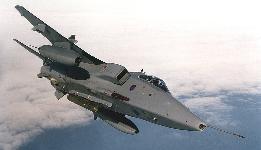


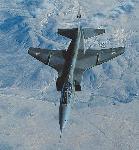
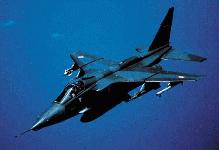
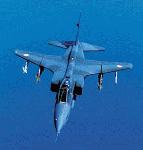
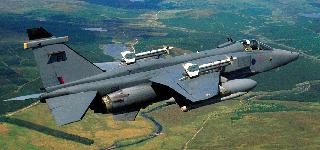
Sources and Resources
FAS |
Military |
DOD 101 |
Systems |
Aircraft |
ROW ||||
Index |
Search |
Join FAS
http://www.fas.org/man/dod-101/sys/ac/row/jaguar.htm
Maintained by Robert Sherman
Originally created by John Pike
Updated Saturday, June 17, 2000 2:57:06 PM